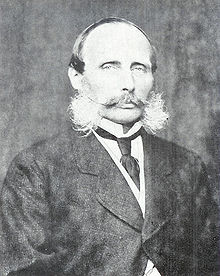Prince Henry of the Netherlands (1820–1879)
You can help expand this article with text translated from the corresponding article in Dutch. (May 2013) Click [show] for important translation instructions.
|
| Prince Henry | |
|---|---|
 | |
| Born | 13 June 1820 Soestdijk Palace, Baarn |
| Died | 13 January 1879 (aged 58) Walferdange Castle, Walferdange |
| Spouse | |
| House | Orange-Nassau |
| Father | William II of the Netherlands |
| Mother | Anna Pavlovna of Russia |
| Military career | |
| Allegiance | |
| Service | |
Prince William Frederick Henry of the Netherlands (Dutch: Willem Frederik Hendrik; 13 June 1820 – 13 January 1879) was the third son of King William II of the Netherlands and his wife, Grand Duchess Anna Pavlovna of Russia. He was born at Soestdijk Palace.
Prince Henry became Governor of Luxembourg in 1850, in which capacity he served until his death in 1879. During his tenure, he worked with the government to launch the reactionary Coup of 1856, which consolidated power in the monarchy and the executive.[1] However, most of the changes were reversed by the new constitution issued in 1868 after the 1867 Luxembourg Crisis,[1] during which the crown tried to sell the grand duchy to France.
Career
[edit]
Prince Henry was appointed an officer in the navy in his teens, and served many years, whence the sobriquet de Zeevaarder ("the Navigator"), after the Portuguese Prince Henry the Navigator. He visited the Dutch East Indies in 1837, remaining there for seven months.
Personal life
[edit]He married twice. On 9 May 1853, in Weimar, he married Amalia Maria da Gloria Augusta of Saxe-Weimar-Eisenach (Ghent, 20 May 1830 - Walferdange Castle, 1 May 1872). On 24 August 1878, in Potsdam, he married Marie Elisabeth Louise Frederica of Prussia (Marmorpalais, 14 September 1855 – Schloss Albrechtsberg, 20 June 1888). Both marriages were childless. At the time of his death at Walferdange Castle from measles, he was third in line of succession to the Dutch throne.
Throughout his life, his title was His Royal Highness Prince Henry of the Netherlands, Prince of Orange-Nassau.
Legacy
[edit]
The Prins Hendrikkade, a major street in Amsterdam, was named after Prince Henry following his death in 1879. A bust of Henry stands on the street.
The Prins Hendrik Stichting, a charity founded by Prince Henry in 1871 and named after him, provides care to sailors and their widows.[2]
In Luxembourg, an oak tree in Grünewald forest was planted and named after him following his death in 1879. The city of Luxembourg also has a street named after Henry, the Boulevard Prince-Henri.
Honours
[edit]He received the following orders and decorations:[3]
 Netherlands: Grand Cross of the Order of the Netherlands Lion
Netherlands: Grand Cross of the Order of the Netherlands Lion Luxembourg: Grand Cross of the Order of the Oak Crown
Luxembourg: Grand Cross of the Order of the Oak Crown Russian Empire: Knight of the Order of St. Andrew the First-called, 10 June 1834
Russian Empire: Knight of the Order of St. Andrew the First-called, 10 June 1834 Kingdom of Prussia: Knight of the Order of the Black Eagle, 8 February 1842[4]
Kingdom of Prussia: Knight of the Order of the Black Eagle, 8 February 1842[4] Saxe-Weimar-Eisenach: Grand Cross of the Order of the White Falcon, 4 February 1845[5]
Saxe-Weimar-Eisenach: Grand Cross of the Order of the White Falcon, 4 February 1845[5] Württemberg: Grand Cross of the Order of the Württemberg Crown, 1849[6]
Württemberg: Grand Cross of the Order of the Württemberg Crown, 1849[6]
 Sweden-Norway: Knight of the Order of the Seraphim, 23 February 1850[7]
Sweden-Norway: Knight of the Order of the Seraphim, 23 February 1850[7]

 Ernestine duchies: Grand Cross of the Saxe-Ernestine House Order, June 1853[8]
Ernestine duchies: Grand Cross of the Saxe-Ernestine House Order, June 1853[8] Nassau: Grand Cross of the Order of Adolphe of Nassau, with Swords, June 1858[9]
Nassau: Grand Cross of the Order of Adolphe of Nassau, with Swords, June 1858[9] Electorate of Hesse: Knight of the House Order of the Golden Lion, 12 September 1859[10]
Electorate of Hesse: Knight of the House Order of the Golden Lion, 12 September 1859[10] Oldenburg: Grand Cross of the House and Merit Order of Duke Peter Friedrich Ludwig, with Golden Crown, 24 February 1878[11]
Oldenburg: Grand Cross of the House and Merit Order of Duke Peter Friedrich Ludwig, with Golden Crown, 24 February 1878[11] Belgium: Grand Cordon of the Order of Leopold (military), 25 March 1878[12]
Belgium: Grand Cordon of the Order of Leopold (military), 25 March 1878[12]
Ancestry
[edit]| Ancestors of Prince Henry of the Netherlands (1820–1879) |
|---|
Footnotes
[edit]- ^ a b Christiane Huberty (November 2006). "Le Conseil d'État – un produit du conflit constitutionnel du milieu du XIXe siècle" (PDF) (in French). forum.lu. Retrieved 2 December 2009.
- ^ "Historie", Prins Hendrik Stichting (Dutch)
- ^ Staatshandbuch für das Großherzogtum Sachsen / Sachsen-Weimar-Eisenach (1869), "Genealogie" pp. 9-10
- ^ Liste der Ritter des Königlich Preußischen Hohen Ordens vom Schwarzen Adler (1851), "Von Seiner Majestät dem Könige Friedrich Wilhelm IV. ernannte Ritter" p. 22
- ^ Staatshandbuch für das Großherzogtum Sachsen / Sachsen-Weimar-Eisenach (1864), "Großherzogliche Hausorden" p. 11
- ^ Württemberg (Kingdom). Statistisches Landesamt (1877). Staatshandbuch für Württemberg. Druck von W. Kohlhammer. p. 22.
- ^ Sveriges statskalender (in Swedish), 1877, p. 368, retrieved 6 January 2018 – via runeberg.org
- ^ Staatshandbücher für das Herzogtums Sachsen-Altenburg (1869), "Herzogliche Sachsen-Ernestinischer Hausorden" p. 20
- ^ Staats- und Adreß-Handbuch des Herzogthums Nassau (1866), "Herzogliche Orden" p. 12
- ^ Hessen-Kassel (1866). Kurfürstlich Hessisches Hof- und Staatshandbuch: 1866. Waisenhaus. p. 14.
- ^ Hof- und Staatshandbuch des Großherzogtums Oldenburg0: 1879. Schulze. 1879. p. 35.
- ^ Almanach royal officiel: 1879. 1879. p. 51.


 French
French Deutsch
Deutsch